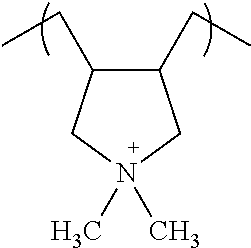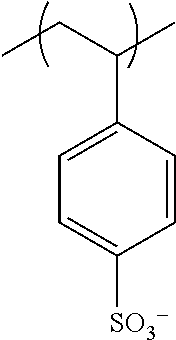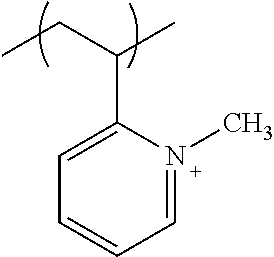Surface treatment for cell culture
- Summary
- Abstract
- Description
- Claims
- Application Information
AI Technical Summary
Benefits of technology
Problems solved by technology
Method used
Image
Examples
example 1
Polyelectrolyte Multilayer, PEMU, Buildup
[0122][PDADMA / PSS, x]n multilayers, examples of PECTF, were built manually at room temperature using a layer-by-layer assembly on square pieces of polished silicon (Si 100), where “n” indicates the number of bilayers and x represents the NaCl concentration used for the buildup. For example [PDADMA / PSS, 1.0]10[PDADMA, 1.0] indicates 20 alternating layers of PDADMA and PSS, starting with PDADMA on the Si wafer, using 1.0 M NaCl, terminated with a layer of PDADMA in 1.0 M NaCl. 20-layer PEMUs prepared with 0.15M NaCl had a thickness of around 40 nm, while films prepared with 1.0M NaCl had a thickness of around 400 nm.
[0123]Si wafers were cleaned by immersion, for 10 min, in “piranha” solution (70:30 mixture of sulfuric acid and hydrogen peroxide). Wafers were then rinsed with deionized water and dried with a stream of N2. The buildup of the PEMUs was done manually using 1000 mL beakers and a holder with a capacity for 6 wafers. The dipping time ...
example 2
Cell Culture
[0124]3T3-Swiss albino fibroblasts (initially purchased from American Type Culture Collection as ATCC CCL-92 cells and maintained in the lab for numerous generations) were cultured in Dulbecco's Modified Eagle's Medium supplemented with 1 g L−1 L-glutamine, 1.2 g L−1 sodium bicarbonate (Sigma-Aldrich), 10% Cosmic Calf Serum (Thermo Scientific), 100 U mL−1 penicillin G, 100 μg mL−1 streptomycin, 0.25 μg mL−1 amphotericin B and 10 μg mL−1 gentamicin (Invitrogen). Cells were incubated at 37° C. with 5% CO2 (Nu-4750, NuAire). Uncoated 6- or 12-well plates were used as controls
example 3
Microscopy and Live Cell Imaging
[0125]Fixed cell images were collected using a Nikon TS100 microscope fitted with a Nikon DS-Ril camera. Live cells were imaged with a Nikon Ti-E inverted microscope and a Cool Snap HQ2 camera. Cells were housed in a LiveCell chamber (Pathology Devices), incubated at 37° C. and monitored for 72 hours in 5% CO2. 60% relative humidity was used to reduce media evaporation.
PUM
 Login to View More
Login to View More Abstract
Description
Claims
Application Information
 Login to View More
Login to View More - R&D Engineer
- R&D Manager
- IP Professional
- Industry Leading Data Capabilities
- Powerful AI technology
- Patent DNA Extraction
Browse by: Latest US Patents, China's latest patents, Technical Efficacy Thesaurus, Application Domain, Technology Topic, Popular Technical Reports.
© 2024 PatSnap. All rights reserved.Legal|Privacy policy|Modern Slavery Act Transparency Statement|Sitemap|About US| Contact US: help@patsnap.com










